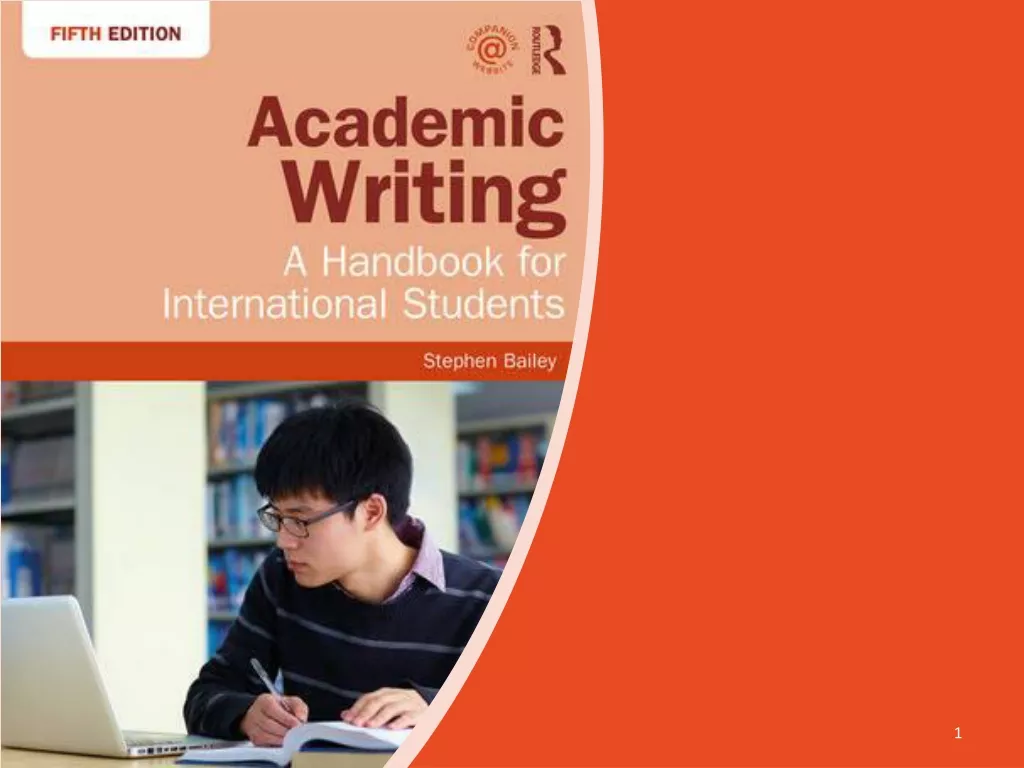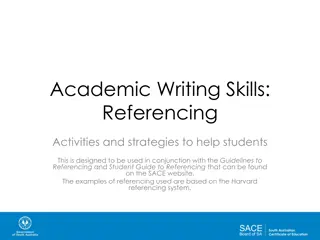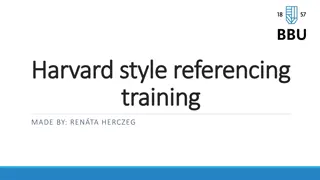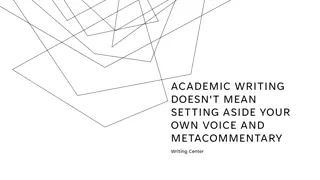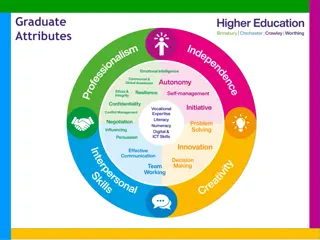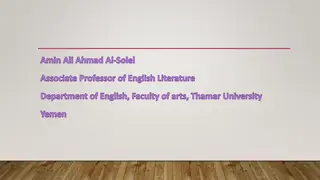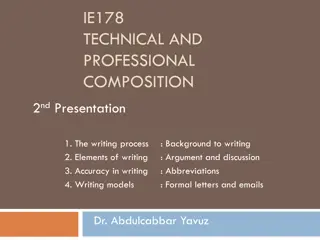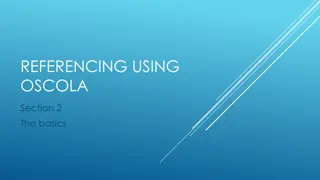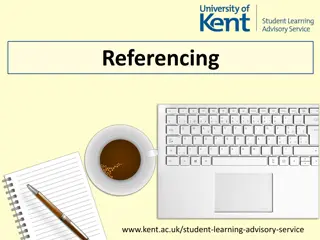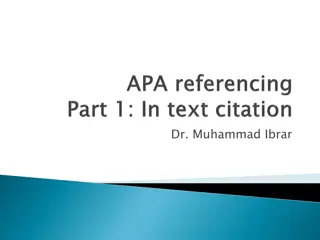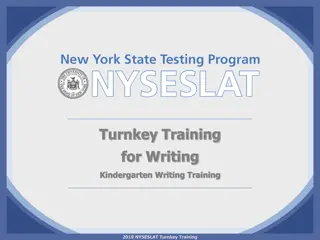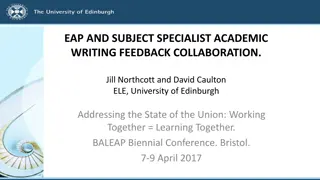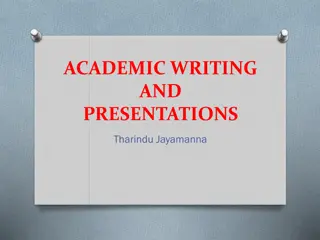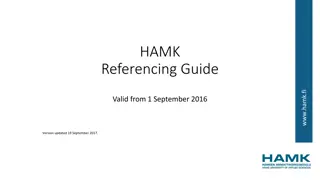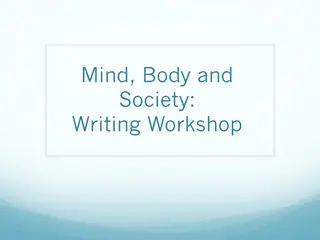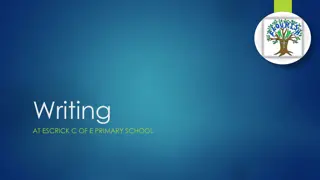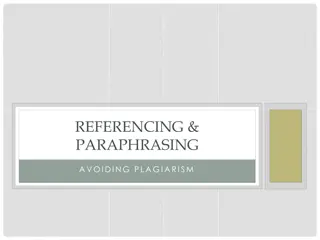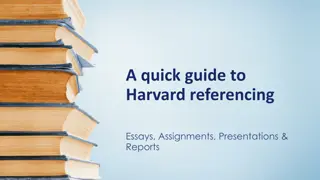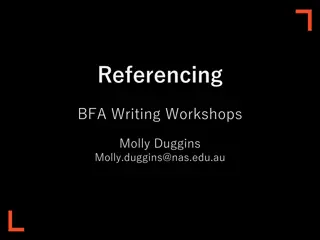Referencing in Academic Writing
Explore the importance of referencing in academic writing, how to cite sources properly using the Harvard system, and avoid plagiarism. Learn what information is needed for referencing and how to create reference lists and bibliographies.
Download Presentation

Please find below an Image/Link to download the presentation.
The content on the website is provided AS IS for your information and personal use only. It may not be sold, licensed, or shared on other websites without obtaining consent from the author.If you encounter any issues during the download, it is possible that the publisher has removed the file from their server.
You are allowed to download the files provided on this website for personal or commercial use, subject to the condition that they are used lawfully. All files are the property of their respective owners.
The content on the website is provided AS IS for your information and personal use only. It may not be sold, licensed, or shared on other websites without obtaining consent from the author.
E N D
Presentation Transcript
Harvard Referencing What we will cover: What referencing is Why we do it How we do it Sources of further information. This session will show you how to cite and reference in a standard manner using the Harvard system.
What is a reference A reference is a detailed description of any document from which you have taken information, e.g. A complete book, a chapter within it, journal/magazine article, a website etc. The Concise Oxford Dictionary (1999, p 301) defines reference as : the action of referring to a source of information or higher authority
Why Reference? Allow your lecturer to source your research Help support any arguments you are making. To demonstrate the breadth of your research. Required academic practice Credit the work of others (avoid being accused of Plagiarism)
Plagiarism The Concise Oxford Dictionary (1999, p263) defines plagiarise as to take the work or idea of someone else and pass it off as one s own Failure to acknowledge your source of information and pass off someone else s work as your own could lead to suspicion of plagiarism. Plagiarism is taken very seriously within the college and it may result in disciplinary action
Cite and Write Making reference to other work is called citing or in text referencing Full details of the work that are cited are given at the end of your written work in the form of a reference list. Items that you have used in your background reading, but not cited, may be included under the heading bibliography , after the reference list.
Referencing in context Citation and Reference.
What Information Do I Need? Books Surname of author(s) , comma, initials(s) full stop. Year of publication (in brackets) Title , full stop. (in italics) Edition Place of publication (city or town) followed by a colon Publisher s name, full stop. Cottrell, S. (2008) The Study Skills Handbook. 3rd ed. Basingstoke: Palgrave Macmillan. Tortora, G J.and Derrickson, B. (2007) Introduction to the human body: the essentials of anatomy and physiology. 7th ed. New York: Wiley.
Editors If the book is edited, use of the editor(s) followed by (ed.) in place of the author. Example Haralambos, M (ed) (1996) Sociology: a new approach. 3rd ed. Ormskirk: Causeway Press Ltd. Corporate Author When something is published by an organisation or a company there will probably be no individual author that you can identify. Example Scottish Social Services Council (2008) Migrant workers research: a report to the Scottish Social Services Council 2008. Dundee: Scottish Social Services Council.
Journals/magazines Information for journal articles can generally be found on the contents page. When referencing you need to include: Surname of the author (s) comma initial (s) full stop. Year of publication in brackets Title of the article Title of the journal (in italics) comma. Volume number, issue part number (in brackets), comma First and last pages of the article separated by a hyphen and indicated by the abbreviation pp if more than one page. Examples Daniels, S (2008) Animal magic, Nursing Standard, 23 (8), p.28 MacBrain, S (2007) Colour me beautiful, Guild News , `April pp 78-86
Electronic Information Authorship or source of information. If this is not clear use whoever you think is responsible for the item. The date of publication (in brackets) This is the date when the pages were most recently updated. It usually appears at the bottom of the page. The title (in italics) Use the home page title if the specific document title is unclear. The type of resource in square brackets eg [online] The URL (uniform resource locator for a web address) The date the source was accessed [in square brackets] Examples: U.S. National Library of Medicine (2008) Health topics: Stress [Online] MedlinePlus Available at: http://www.nlm.nih.gov/medlineplus/stress.html [assessed 4th Dec 2008] Web address (URLs) may change or disappear completely this is why it s essential that the date you actually accessed the information is recorded. Get into good habits, cut and paste the web address to any document you are working on. It is easier to delete information you no longer require than trying to back track trying to relocate your source.
Quotations If you make a direct quote from another source of information you must use quotation marks to indicate this. The author(s) and date must be stated and if possible the page number from which the quote was taken. Example Webb (1999) said that prejudice is commonly based on , or justified by, a stereotype. (Webb 1999, p16) Try not to use quotations too often and vary the way you introduce them into your text. The full reference to your source of the quotes should be listed with your other references
Listing your references at the end of your work Only make reference to documents or sources of information you have referred to within the text of your work. The list must be in alphabetical order of the author s surname. Example [anon] Haralambos, M Tortora, G. J. Webb Where there is no obvious author use [anon] If you cannot find a date of publication, make this clear eg [no date] or [undated]
Think About it Who When What Where How
Good habits Take the full details of each source of information as you use it as it may not be available later. Cut and paste the address of any electronic sources as you use them. If your unsure of how to do any of this, ask for assistance. Library and lecturing staff are always available to help.
Where Do I Find the Reference details? This, obviously, varies depending on the type of source you are citing. Books - check the title page and the back of title page. Journals check the front cover, spine or first page. Specific article details can be found on the content page or the beginning or end of the article itself. Websites First page of the website, Url at the top address bar. Plus. If printing , the url will be at the bottom of the page Dates Etc are usually at the bottom of the page. http://www.bbc.co.uk/science/0/21685448
Practice with notes Importance of good practice at this stage in your academic career. Refer back to notes and other Online resources which cover all situations: Anglia Uni. used for checking problems. http://libweb.anglia.ac.uk/referencing/harvard.htm REF ME App. Neil s Toolbox http://www.neilstoolbox.com/bibliography-creator/ Microsoft reference Tool - Short video from Anglia Rusking Uni. on how to use it.
Using Microsoft word Mary has a little lamp it s face as white as snow and everywhere that Mary went the lamp was sure to go. (please note, while the basics are there, the reference does not conform with the college harvard system) Mary had a little lamb (Brown, 2016) it s face as white as snow (BBC, 2016) and everywhere that Mary went the lamb was sure to go (Brown, 2016) BBC, 2016. Nursery Rhymes. [Online] Available at: www.bbc.co.uk [Accessed 16 aug 2017]. Brown, J., 2016. How to look after lambs. Edinburgh: Phaidon. Brown, J., 2016. Lost sheep. 2nd ed. London: Penguin.
Short Quiz A bit of fun you may like to try for yourself to test your knowledge! Harvey the Referencing Cat . http://library.northampton.ac.uk/liberation/ref/cat.php


